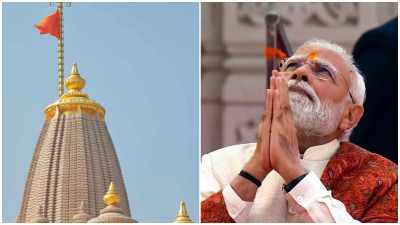Stay updated with the latest - Click here to follow us on Instagram
Traditions on creating idols to their send-off: Three theme-based Ganpati mandals in Mumbai
For the past two years, Tejukaya mandal has been making the idol with eco-friendly materials, of paper and water colours only.
 The Dongri Cha Raja idol this year is 21 feet tall. (Express photo by Amit Chakravarty)
The Dongri Cha Raja idol this year is 21 feet tall. (Express photo by Amit Chakravarty)Tejukaya
Its speciality is that on the day of the visarjan, volunteers working with the Tejukaya Mandal carry the 22-feet idol into the waters bearing its weight on their shoulders, without the use of trolleys, trucks or any other machinery. The visarjan of this idol takes place at Chowpatty, and once the mandal volunteers approach the beach, the idol is mounted off the truck and physically carried into the sea. For the past two years, this mandal has been making the idol with eco-friendly materials, of paper and water colours only.
 Tejukaya Ganpati near Lalbaug. (Express photo by Amit Chakravarty)
Tejukaya Ganpati near Lalbaug. (Express photo by Amit Chakravarty)
Parel Cha Raja
This mandal was established in 1947, the year of Independence, by the residents of Lalbaug – Parel. This idol is located in the heart of Mumbai, in Parel, and is popular for its idol’s unique standing position. The organisers have always made the idol in a standing position, as avatars of Hindu deities Vishnu, Shiva and Ram. This year, the idol is an avatar of deities Ganesh and Laxmi named Gajalaxmi. It is 26 feet tall. However, during visarjan, the idol has to pass under the Lalbaug Bridge, which is 23 feet tall. So the ‘mukut’ or crown of the idol is made foldable.
 Parel Cha Raja. (Express photo by Amit Chakravarty)
Parel Cha Raja. (Express photo by Amit Chakravarty)
Chinchbunder Dongri Cha Raja
This mandal was established in 1939 in yet another area that contributed to the freedom movement in south Mumbai.
This year, the idol is 21 feet tall. Like every year, this year too, the mandal has decided to donate all funds it will receive during the 10 days of the festival to a social cause. During the pandemic, the funds were used to purchase food which was donated across the state.
 Dongri Cha Raja near Sandhurst Road station on the first day of Ganeshotsav in Mumbai.
Dongri Cha Raja near Sandhurst Road station on the first day of Ganeshotsav in Mumbai.(Express Photo by Amit Chakravarty)







